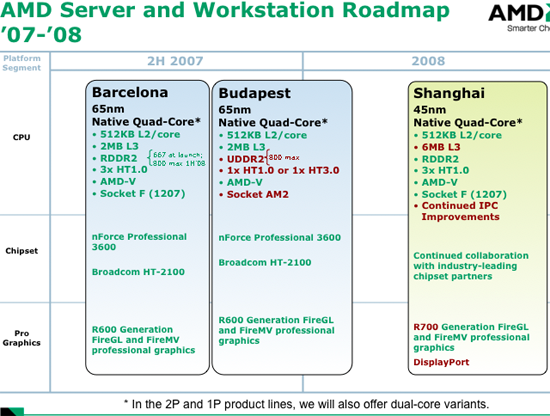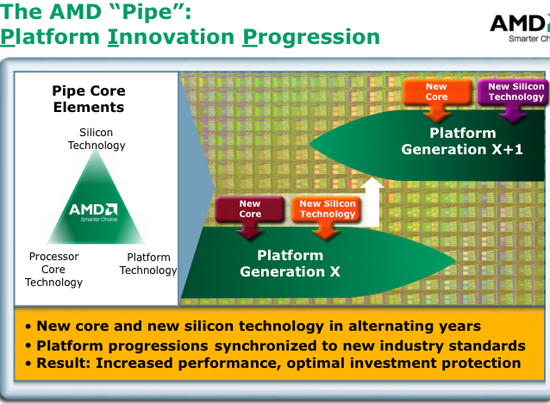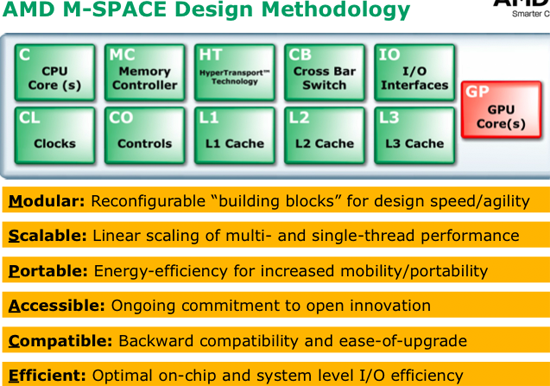Shanghai: What Immediately Follows Barcelona
In the second half of 2008, AMD will introduce its first 45nm processor under the codename Shanghai.
Shanghai will be an evolutionary step above Barcelona, adding a larger L3 cache and some IPC enhancements at both the core and North Bridge levels. Shanghai will keep the same 512KB L2 cache per core of Barcelona, but grow the shared L3 cache from 2MB to a full 6MB. Note that this is still less cache than Penryn will offer in its quad-core configurations, but with AMD's integrated memory controller, larger caches aren't as necessary.
Shanghai, like Barcelona, is targeted at the server market. There will be a desktop variant also introduced in the second half of 2008 with similar specs. Shanghai and its desktop equivalent will be socket-compatible with Barcelona/Phenom motherboards.
AMD has also indicated that Shanghai will begin AMD's transition to DDR3 on the desktop, indicating that the desktop version may be available in two different sockets: AM2 for DDR2 support, and AM3 for DDR3 support. In the first half of 2009, Sandtiger will follow Shanghai in the server space with a brand new architecture (we'll talk about this core shortly). Sandtiger will be exclusively DDR3 and will definitely require a new platform, and just like Shanghai there will be a desktop variant of Sandtiger as well.
Intel : tick-tock :: AMD : Pipe?
One thing we've been waiting to hear from AMD is how it would compete with Intel's tick-tock cadence of microprocessor releases. To recap, Intel's new model shows that every two years it will introduce a new microprocessor architecture, and on the alternate year in between it will introduce a new manufacturing process on the existing architecture.
Today, AMD confirmed that it, too, would be releasing a new microprocessor architecture every two years, and a new manufacturing process on the alternate years. AMD attempted to go one step further and tie platform technology to the cadence as well; confirming that every two years the platform would change, alongside the microprocessor architecture, to support new features as they are available. It's a minor distinction but the main point is that AMD is committed to Intel's 2-year processor cycle.
Oh, and the acronym is horrible guys.
mmmm-space
In our AMD: The Road Ahead article we looked at AMD's modular approach to CPU design going forward:AMD has now attached a marketing name to its modular core approach: M-Space:

The principle is still the same; these discrete blocks within a microprocessor can be things like GPU cores, CPU cores, memory controllers, specialized hardware, etc... There's nothing really new here, we just wanted to make sure you were up to date with the latest and greatest in AMD marketing so you don't get confused.
The next part however, we can't guarantee that it won't confuse you.










31 Comments
View All Comments
flashbacck - Thursday, July 26, 2007 - link
Whoever decided those acronyms were necessary should be fired.fzkl - Thursday, July 26, 2007 - link
Like mentioned, the obvious great benefit of having low power x86 chips on mobile phones is the software aspect. PC applications can now run on phones reducing aspirin needs for developers. However, what does this mean in terms of security? Can we see mobile phones needing frequent patches, antivirus, firewalls like in the case of desktops?If this were to be the case we would have successfully made a simple device like the mobile phone(in usage terms) a high maintenance product which a layman might have trouble with.
sheh - Thursday, July 26, 2007 - link
x86 doesn't imply any OS or API. Linux, which is commonly used today on all kinds of devices, can work just as well on x86. Conversely, nothing prevents virus writers from writing viruses for Linux running phones.beyoku - Thursday, July 26, 2007 - link
what happened? Was this article recelty pulled off or something?NDA???
Guuts - Thursday, July 26, 2007 - link
Looks to me like he's trying to get the images working...erwos - Thursday, July 26, 2007 - link
Fusion looks like it'll be a fantastic chip for UMPCs and laptops. Hopefully they'll manage to squeeze more than CPU one core on there, too. Bobcat looks similarly fun - x86 phones! VIA was also discussing this idea, and I could really go for it.That said, AMD is really under-delivering with Barcelona - I suspect the next few years will be pretty rough. Intel has set a low ceiling price for the Barcelonas ($270 - same as the Q6600), and that's not going to be good for AMD's margins.
mlau - Thursday, July 26, 2007 - link
Embedded is ruled by ARM, Freescale, mips and sh derivates; amd and intel are going to have a tough time getting a super-ugly system like pc-x86 (with it's
legacy baggages "bios", "acpi" [you know, the stuff windows requires to run], ...) into that space.
Spoelie - Friday, July 27, 2007 - link
you do not need to have those things to run an x86 cpuloot at EFI for example, in use by apple on their x86 based macs = no more bios.
qpwoei - Sunday, July 29, 2007 - link
The real problem with x86 is that it's inherently not power efficient. To get good x86 performance requires lots of transistors and lots of power due to complex decoders and schedulers. A much simpler architecture like ARM requires very few transistors to run efficiently (at the expense of slightly less compact executable code), and is much more suited for battery-powered devices.Not to say that there won't be x86-powered devices in the future, just that I don't expect them to really gain much of a foothold in any place where battery life is important (eg: phones).
ss284 - Thursday, July 26, 2007 - link
Return of the Jedi